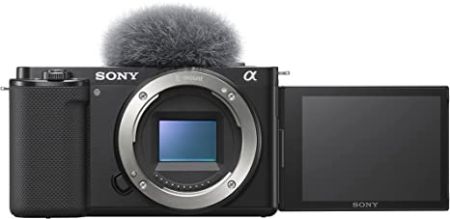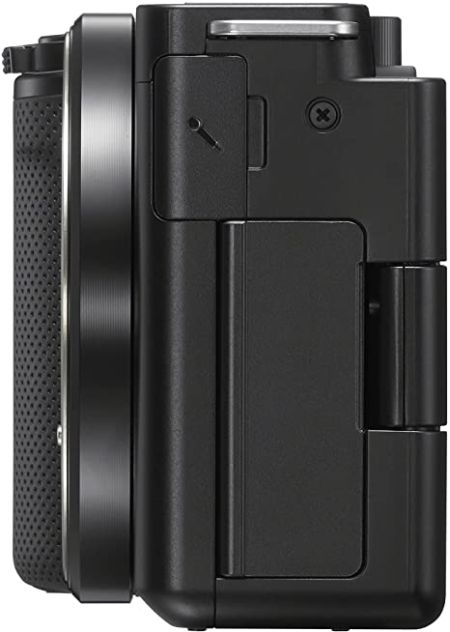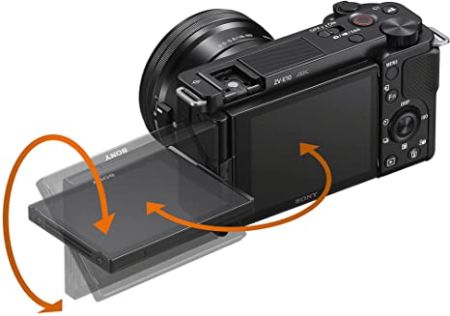The Sony ZV-E10 is a coherent hole filler in Sony’s setup. A vlogging-centered camera with an articulating screen helped receivers, and a conservative body, it’s a strong little video device and takes great photographs.
The ZV-E10 certainly is more than a little flawed, with its three fundamental constraints being a huge moving screen while panning, a non-contact menu framework, and no 4K catch at 60p (which isn’t normal at the cost). Move beyond those limits however and you’ll view it as a reasonable, video-centered crossover with strong sound choices.
The ZV-E10 is worked with the necessities of video-first makers, especially vloggers, as a primary concern. Accordingly, it drops the EVF, worked in glimmer, and Mode dial from the stills-first a6100.
All things considered, it utilizes a quality three-container mouthpiece (a windscreen is incorporated) and adds a swing-out, forward-looking LCD. It’s a thin, light camera — 2.5 by 4.5 by 1.8 inches (HWD) and 12 ounces.
Overview
Sony is offering the camera in a dark or white completion. On the off chance that you’re as of now in the E-mount mirrorless framework, you can get it as a body as it were. There’s a packed choice with the E PZ 16-50mm for $799.99, yet if selfie video blogs are your thing, you might lean toward a more extensive zoom. The camera depends on advanced adjustment to enhance focal point based IS; it’s very powerful, however, it crops the perspective on your focal point.
It’s worked around an APS-C sensor, more modest than the full-outline chips Sony places in its a7 series. You can utilize both full-outline (FE) and made-for-APS (E) focal points. There are normally a few punishments of cost and weight by selecting full-outline glass, yet it’s an or more if you’re as of now in the Sony framework.

The grasp is excessively little to utilize handheld with a major focal point, as holding the focal point while utilizing the back show to approach shots is excessively inconvenient. A stand proved to be useful there, as well concerning some lengthy openness pictures. Generally, I utilized the camera handheld alongside the GP-VPT2BT Wireless Shooting Grip, accessible independently for $150.
The hold interfaces with the ZV-E10 through Bluetooth and incorporates controls to record cuts, change the zoom, and switch Background Defocus (erring on that later). It’s a nearly required extra for handheld use — you’ll normally hold the camera steadier with a gun-style grasp — and it folds out into a helpful tabletop mount. Slant and turn are upheld, as well. Assuming that you’re purchasing the camera, you ought to attempt to make room in your spending plan for the hold.
Delivery Date and Cost
The Sony Alpha ZV-E10 camera is accessible now at AED 2,999 and will package with the E PZ 16-50mm F3.5-5.6 OSS power long-range focal point. It’s accessible at all driving retails as well as Amazon(opens in a new tab).
This implies the ZV-E10 is in the middle between the Sony ZV-1 and the Sony A6100, albeit the last option’s as of late limited cost cuts it down the ZV-E10’s level. While the A6100 appears to be legit for stills photographic artists, the ZV-E10 has better video-related highlights, ergonomics, and ports.
With a sticker price that is not a lot higher than the Sony ZV-1 smaller camera, Sony is giving you a decision between a pocketable across-the-board vlogging camera (the Sony ZV-1) and the adaptability and bigger sensor of a compatible focal point camera (the ZV-E10).
Power and Connectivity
The camera incorporates Bluetooth and Wi-Fi to interface with a cell phone — you’ll utilize the Sony Imaging Edge Mobile application for Android and iOS for controller and record moves. It incorporates USB-C to interface with a PC for moves or uses as a webcam. It follows UVC and UAC principles, so it’ll work with Macs, PCs, and Android 11 cell phones. Streaming is at 720p and incorporates a sound feed.
The ZV-E10 is fueled by Sony’s frequently regretted NP-FW50 battery. It’s appraised for around 80 minutes of record time or 440 photographs, yet your mileage will fluctuate because of how you utilize the camera. In a hurry charging is accessible, yet all at once, it’s quite sluggish. It required around three hours to re-energize an almost exhausted battery with an 87W Apple charger.

The hot shoe upholds Sony advanced receivers. You can likewise utilize simple mics through a 3.5mm info, connect a bunch of headphones for checking (additionally 3.5mm), or send a clean 4:2:2 8-digit video signal out of the miniature HDMI port to take care of an Atomos Ninja V or outside another recorder.
Pictures and videos are saved money on SD memory. There’s a solitary space settled into the battery compartment. The ZV-E10 upholds UHS-I move rates, and can likewise utilize Sony Memory Stick Duo cards.
Design and Build-in
You’ll know the ZV-E10 is a Sony camera when you push the touchscreen to communicate with the menus and nothing occurs. That’s right, while Sony presented an extravagant new touch menu for the Sony A7S III and FX3, the more up-to-date ZV-E10 compels you to explore the UI with the four-way wheel to one side of the presentation, the importance we’re trusting that the component will arrive on a lower-end camera.
You’ll likewise perceive a lot of Sony-isms in the camera’s plan language a long time before you get to the menu. The highest point of the camera includes a Multi-Interface hot shoe mount, which upholds computerized sound gadgets, close by a grille that covers a three-case mouthpiece.
Beneath the power switch is a flip to cycle across Photo, Video, and Sony’s S&Q (‘Slow and Quick’) mode for time-lapses. There’s likewise a devoted film record button, and a Bokeh Switch button (which bends over as C1). At last, for the top, there’s a wheel that controls the opening of the course and is worked by a thumb, a screen discharge button, and a zoom switch.
- Small size
- Articulating display
- Excellent autofocus
- Excellent stills camera
- Credentials for solid audio
- Battery life is short
- Video with digital stabilization gains crop
- Insufficient touch controllers
- Slow in-camera charging for usage on the fly
- None in 4K 60fps recording
The rear of the camera gladly grandstands the articulating screen and to one side are menu, Fn, playback, and erase buttons. There’s likewise a turning wheel that works as a four-way cushion. While the camera’s body is magnesium, there’s a delicate touch hold to the right half of the buttons for a thumb to cuddle into, and the material folds over the side of the camera to the front grasp as well.
Take a look at the ZV-E10’s underside and you’ll find a spring-stacked entryway covering the single SD card and battery spaces. There’s likewise a standard mount string fitting, and on the port-side of the camera is an earphone jack, miniature HDMI, and a USB-C port under one entryway, with a receiver port under a different unstable fold.
The articulating screen is a major genius for vlogging, feels strong, and implies the screen’s safeguarded when the screen isn’t confronting outwards. For video shooters who don’t video blog, there’s a contention to be made for the customary shifting screen on other Sony cameras and the Blackmagic Pocket Cinema Camera 6K Pro, as it makes for a less off-kilter grasp while holding the camera at a low, steadied point. By and by, the ZV-E10’s completely articulating screen is certainly more adaptable.
For photography, the ZV-E10 falls behind cameras with viewfinders with regards to ergonomics. In any case, the articulating screen finishes the work, though in a nitty-gritty way. With a similar 921k, the 3-inch board found on the A6100, its viewpoint proportion is improved for photographs instead of video. The camera additionally works with contact to-concentrate and Sony’s brand name eye and article following, yet all the same, favoring that later.
Fast, Reliable Autofocus
The ZV-E10 involves a similar self-adjust framework as other ongoing APS-C models from Sony, including the a6100 and the move forward model in the line, the a6400. It blends stage and differentiation identification, spreading inclusion across the casing. The self-adjust can follow subjects whenever they’ve been procured, and it upholds face and eye location for individuals and pets.
There are a few tweaked choices for vloggers. One is Product Showcase, a one-contact setting for item commentators and other people who present things to the camera. Sony’s face identification will regularly stay with you regardless of what is in the middle of among subject and camera, however, this focuses on the center around objects near the focal point. It functions admirably.

More connected with metering than the center, the camera is likewise tuned to set openness given identified faces. This is particularly valuable while recording video with changing light — say a walk-and-talk moving from daylight to shadow, and for scenes with a solid backdrop illumination. Assuming that you’re featuring in your video blog, you’ll need to be appropriately uncovered.
The Center is quick, and the camera does as great a task following activity as others in the Sony series. We believe it to be among all that you can find in an APS-C camera, and it’s upheld by an extremely expedient burst rate, of 11fps. It oversees 111 JPGs, 48 Raw, or 43 Raw+JPGs before the cradle fills, yet if you do fill it as far as possible, you’ll have to hang tight for all the photographs to save to memory before you can change to a video mode. We timed it about 25 seconds for Raw, 37 seconds for JPG, and 76 seconds for Raw+JPG matches.
Video and picture quality
We tried the ZV-E10 with different focal points, including the Sony E 16-50mm f/3.5-5.6 OSS, FE 24-70mm f/2.8 OSS, FE 12-24mm f/4, and the 135mm f/1.8 GM. Handheld in splendid to diminish scenes, each mix conveyed a rich shot with noteworthy profundity, detail, and difference.
Picture commotion is all around controlled all through the responsiveness range on the ZV-E10, regardless of whether you choose higher awarenesses, for example, ISO 6400. On the off chance that you’re shooting JPEGs, we’d suggest exchanging the camera’s High ISO NR (sound decrease) setting to low, as the ‘Ordinary’ setting can be a piece graceless.
Video quality is likewise phenomenal while keeping the camera still, with film from the ZV-E10 (shot with 8-cycle variety profundity utilizing 4:2:0 sub-inspecting) conveying a lot of detail, while movement is overall quite smooth, and sound quality is additionally great.
The consideration of the three-container receiver found on the Sony ZV-1, alongside the packaged windshield, is welcome for greater reinforcement sound. In any case, on the off chance that you can wire in some outside sound, especially for interview-type situations, you’ll need to.
Final Thoughts
The ZV-E10 is a very close relative of Sony’s two a6000s and a6500, but with some key differences. It’s designed for vloggers, and it makes video the primary focus. The LCD tilts steeply downward to improve audio performance, and there’s plenty of USB power to accommodate a microphone. But others are closing the resolution gap, and it’s not as flexible as other camcorders in its price range.
The Sony ZV-E10 is a mid-level camera that delivers some genuinely unique features, such as the microphone system, but it’s also an example of what to expect as cameras increasingly cater to niche audiences. Now, if only Sony could incorporate this level of audio sensitivity into its higher-end cameras!









